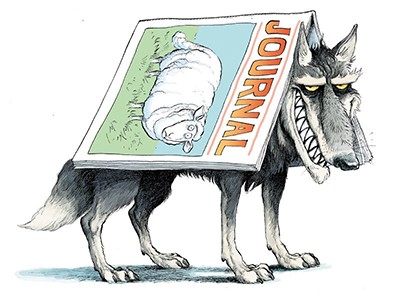
Illustration: David Parkins
The advice
Nature reached out to two researchers for advice. Predatory journals claim to be legitimate scholarly publications, but exploit the open-access publication model to deceive authors into paying them a fee. These publishers often lie about the journal’s impact factor, misrepresent their editorial board and falsely claim that they provide a peer-review process1.
Predatory journals: no definition, no defence
One of the first things you can do to determine whether a journal is predatory or not is to evaluate the e-mail invitation critically, which it seems you’ve already done. “Predatory journals approach so many of us here in Africa. Every day, I get like 20 e-mails asking me to publish something,” says Alexander Kwarteng, a microbiologist at Kwame Nkrumah University of Science and Technology in Kumasi, Ghana. For Kwarteng, an emphasis on publication fees in the e-mail is a red flag. “Most predatory journals like talking about money. They will ask you to send them US$50 or $100 to publish your paper in two weeks.”
“Some journals are obviously predatory, because the topic is fully off from your field of study,” says Jeroen Groeneveld, a palaeoceanographer at the National Taiwan University in Taipei. “Also, these e-mails are often extremely flattering. They’ll include phrases like ‘dearest professor’ and ‘your extremely high standing in the scientific community’. Those are red flags for me.”
Looking for typos, grammatical errors and whether the timestamp of the e-mail matches the standard working hours for the publisher’s purported location can also help to indicate whether a journal is predatory or not, write Susan Elmore and Eleanor Weston in a 2020 publication on how to avoid predatory journals1. The e-mail you received seems to have many of these characteristics, suggesting that it might be from a predatory publisher.
Share your own career problems anonymously
After closely reviewing the e-mail, the researchers we spoke to also recommend looking at the journal’s website to evaluate its credibility. For instance, does the journal have clear guidelines for its peer-review process and timeline? “A journal that promises to accept your manuscript within a week’s time for money is, for me, predatory, as this is simply not possible,” says Groeneveld, who notes that a thorough peer-review and editing process take weeks, if not months or even a year.
Kwarteng also looks at the journal’s citation index, address and telephone numbers. “If a journal says it’s coming from the United States, but the telephone number is from India, that doesn’t make sense,” he says. He also checks out the members of the editorial team and tries to follow the links in their biographies. “Sometimes you click a link that doesn’t go anywhere. That tells me they’re probably a dangerous publisher.” Consider e-mailing the people included on the journal’s editorial board to ask them about the journal. If it turns out to be predatory, then you’ve helped inform these researchers that their information is probably being used deceitfully.
Beyond exploring the website, an online search can provide insights into whether a journal is predatory or not. Groeneveld often searches the journal name with the keyword ‘predatory’ to see what pops up. He also checks Beall’s list, a compilation of potential predatory journals and publishers originally created by librarian Jeffrey Beall, who at the time was employed by the University of Colorado Denver.
Hundreds of ‘predatory’ journals indexed on leading scholarly database
In their paper, Elmore and Weston suggest numerous free resources that can help researchers to identify predatory journals. Examples include databases curated by the Directory for Open Access Journals and SCImago Journal Rank, and guidance provided by the Committee on Publication Ethics. They also recommend using a guide for checking journal quality on the non-profit website thinkchecksubmit.org.
On the basis of these criteria, Nature reviewed the e-mail received by the suspicious ecologist and found that it probably is from a predatory publisher.
Kwarteng and Groeneveld both noted that working out whether a journal is predatory or not can be particularly challenging for early-career researchers, who are often not very familiar with scientific publishers. In those cases, it’s best to reach out to more experienced colleagues for help.
In 2021, a graduate student in Kwarteng’s lab was tricked into publishing their work in a predatory journal. Despite numerous requests for the journal to withdraw the publication, it refuses to do so and continues to ask Kwarteng for money. “I’ve learnt a hard lesson,” says Kwarteng. “We need to continuously educate members of the lab in how to deal with some of these predatory publishers. The truth is, they’re all over the place.”

 Predatory journals: no definition, no defence
Predatory journals: no definition, no defence
 Hundreds of ‘predatory’ journals indexed on leading scholarly database
Hundreds of ‘predatory’ journals indexed on leading scholarly database






